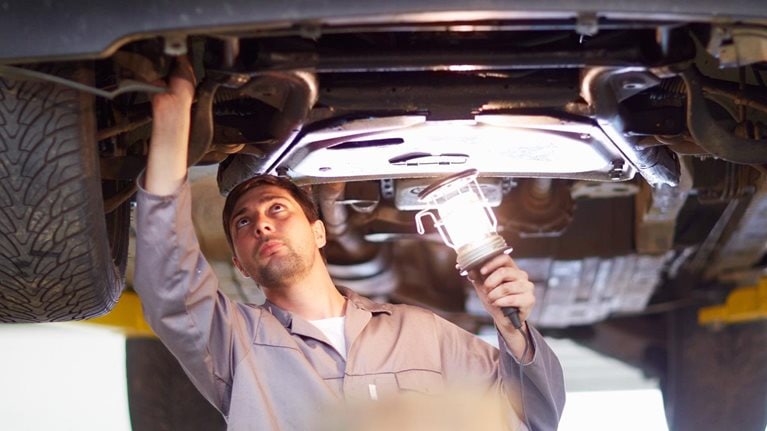Like everyone else, original equipment manufacturers are moving to address their customers’ needs amid sweeping technological change. In the agriculture and construction industries, for instance, heavy equipment OEMs are providing new and different types of solutions.
Customers in these two industries have traditionally been digital laggards when compared with customers in sectors such as mining and oil and gas. Farmers long monitored their crops by walking their fields. Contractors used manual checklists to track progress at construction sites.
More recently, however, agriculture and construction customers have embraced technology solutions provided by next-generation OEMs. Farmers are experimenting with apps and drones to follow field progress and harvests. And contractors are starting to monitor equipment and workforces on their phones.
In a survey that McKinsey and the Association of Equipment Manufacturers (AEM) conducted in 2017, agriculture and construction customers told us they trust OEMs the most to provide them with these new technologies (high-tech companies and component suppliers ranked a close second). We also found that OEMs with service arms have twice the earnings before interest and taxes (EBIT) of peers that don’t.
Despite these findings, construction and agriculture OEMs are not flourishing in aftermarket services—their penetration rates are far below the 75 percent seen in industries such as data storage and wind turbines. This competitive landscape presents an opportunity for OEMs, particularly in aftermarket services and solutions—an area that can provide a less cyclical, more sustainable source of cash, which, in turn, can boost profitability and growth.
To understand the OEM-customer decision journey in the aftermarket, McKinsey and AEM recently teamed up again to survey almost 1,300 contractors and farmers across the United States about how OEMs can better meet their needs.1 The survey revealed that contractors and farmers are satisfied in many areas but they continue to experience significant pain points in equipment usage and maintenance. These include nontransparent pricing, high operating and repair costs, and unresponsive sales reps, dealers, and technicians.
Agriculture and construction OEMs that want to improve their aftermarket sales must offer more innovative products and services—and sell and service them differently. We looked at other industries, including automotive, industrial services, and aerospace, that are using innovative tech solutions in aftermarket services to see what lessons their experiences could offer.
Four themes stood out: pursuing new business models to reduce maintenance and operating costs, mastering the digital channel to engage customers, offering customers connected solutions within an aftermarket-dealer ecosystem, and using new technology to increase the effectiveness of service technicians.
This article offers examples of how OEMs that pursue these solutions could stand a better chance of attracting and retaining digital-hungry customers.
The aftermarket diagnosis

To glean how customers’ experiences in the parts aftermarket can be improved, it is first important to note what they feel is going well. Respondents tell us they believe sales reps in the OEM channel (authorized dealers and service centers) are extremely knowledgeable about equipment. And they believe it is easy to get sales reps’ attention and time.
As one farmer notes, “Dealer sales reps always make the time when you need to consult them.” And respondents feel like sales reps truly care about them when they have questions about products or services. As one farmer puts it, “It’s more of ‘I wanted to let you know for your own benefit’ than a super salesy pitch.”
However, the journey could be improved in several key areas. The first relates to operating and maintenance costs: 67 percent of farmers and 52 percent of contractors say the cost of maintaining equipment is their top problem (Exhibit 1).
Respondents also express a surprisingly high level of frustration with long lead times (Exhibit 2). Among farmers, half say it takes too long for a technician to arrive, 29 percent say it takes too long for a dealer to respond to a request, and 21 percent say they don’t have a way to check for an available repair service. The level of frustration with dealer-response time is actually higher for contractors, at 39 percent, than it is for farmers.

Going outside the OEM channel
Customers have questions about the technical capabilities of OEMs’ channel partners. Almost half of the respondents, both farmers and contractors, tell us that technicians were not able to fix their problems the first time.
When customers are dissatisfied, they go outside the OEM channel, to independent service centers and others, after warranty (Exhibit 3). Our survey finds that, after warranty, 46 percent of farmers go outside the OEM channel, including doing repairs in-house; that number is even larger for contractors, at 64 percent. That represents a significant lost opportunity for OEMs, based on not just lost sales but also lost customer data. In a nutshell, it reduces OEMs’ ability to shape the customer journey.

When we dig deeper into why farmers go outside the OEM channel, cost is the biggest reason, at almost two-thirds, followed by the downtime caused by taking machinery to a dealer, at 39 percent (Exhibit 4). It is a bit more complicated with contractors. They seek out other channels because of cost, but more contractors than farmers see those avenues as more convenient and faster to respond than OEM channels are.

A particularly instructive component of our survey has to do with younger customers (aged 18 to 35), who are three times more likely than their older counterparts to go outside the OEM channel for repairs (Exhibit 5). They tell us their biggest frustration is that repairs and service take too long. As a group, they demand more convenience and are more time sensitive when it comes to repairs. They are also more than twice as likely as older customers (aged 50 and older) to look online for third-party channels for repairs. Going forward, solutions for satisfying younger customers should focus on convenience and interaction through digital channels.

Lost opportunities
If we step back and look at the aftermarket today, about one-third of farmers and contractors, in the aggregate, do their business outside the OEM channel (there is a difference between the groups, with farmers at about 20 percent and contractors at about 40 percent). This group represents a significant lost revenue opportunity for OEMs, because they essentially lose track of customers.
What’s more, if automotive trends apply to the construction and agriculture environment, the share of online parts sales could double over the next five years (Exhibit 6). If we spin that forward, the one-third share of parts sold outside the OEM channel today will become closer to one-half—a significant loss for OEMs.

Capturing market share
Given current conditions in the aftermarket, what can OEMs do to capture all this value, both potential and lost? Here are four actions that other industries have taken to solve customer frustrations that can be applied to agriculture and construction OEMs.
Pursue new business models
To reduce maintenance and operating costs for customers, it is crucial that OEMs look for new business models.
A good example of such innovative thinking is the myAudi functions-on-demand platform. The single technology package for Audi vehicles being introduced in 2019 reduces a lot of complexity. Customers can use an app on their mobile devices to turn on features and service options whenever they want. The app allows owners to manage everything from vehicle Wi-Fi and entertainment features to driver assistance. Vehicle owners get charged only for the features they use. This full connectivity is the type of convenience and digital interaction that younger customers, in particular, are going to come to expect in the future.
Construction and agriculture OEMs are starting to pursue connected business models, though not quite at the same level of complexity. Equipment is increasingly manufactured with built-in sensors and connectivity (for example, driver monitoring and preventive-maintenance alerts) through the OEM brand’s connectivity suite and sold with a free trial or as standard on new equipment.
OEMs should consider ways to integrate more optionality into their offerings. They can give customers the option of choosing features—for example, switching a subscription on and off with seasonality, like yield-monitoring features for farmers. Or, having customers pay only for functions relevant to their immediate business needs, like load monitoring for contractors.
Master the digital channel
To engage customers who are now reliant on digital products, OEMs should offer digital solutions not only to sell parts but also to relieve customer pain points in the aftermarket.
If we look at Amazon’s B2B side, we can see that over the past five years, the number of SKUs listed has grown to close to two million. And the big disruption is yet to come. Amazon is now experimenting with last-mile delivery to ensure that it can deliver parts to customers within two hours; in some cases, the timeline could be shorter than that. Amazon’s experimentation with drones is well known, but it is also looking at floating warehouses, a concept that once seemed fanciful, but no more.
Many OEMs currently maintain their own online-parts databases that allow customers to order the parts they need and have them shipped to local dealers or to them directly. However, pain points in aftermarket parts are often left unresolved because of slow shipping speeds or high shipment costs. Some global equipment OEMs have upgraded their online-parts database to offer free ground shipping, as well as options for next-day or second-day air.
Create more transparency between customers and dealers
Customers are looking for a seamless end-to-end transaction that’s more transparent than anything offered before. Other industries have introduced connected solutions that provide such transparency while also ensuring high-quality output. For example, a large-truck OEM offers a fleet-repair mobile app that seamlessly coordinates a service appointment the moment a vehicle issue is detected. Customers receive notifications on issue severity levels as well as service recommendations. They can quickly schedule appointments and receive price estimates from the closest dealers with the necessary parts.
Would you like to learn more about our Automotive & Assembly Practice?
Once an appointment is scheduled, the dealer receives details on the specific vehicle issue. After the vehicle is dropped off, the app offers status notifications for each stage, including checked in, in service, awaiting approval, and ready for pickup. When the transaction is over, the app logs the maintenance in its historical record.
OEMs can also introduce apps or web portals that allow customers to reach dealers more easily, check for service availability, and track technician wait times and progress. Equipment dealers often offer web portals through which customers can request a service appointment, but even this requires waiting for dealers to figure out their capacity and respond accordingly. A service-time estimator would be a step in the right direction for OEMs’ aftermarket-service arms to address customer frustrations with dealer wait time and transparency.
Improve technician guidance
Some industries are using virtual reality (VR) and augmented reality (AR) to help service technicians identify problems and get repair guidance. For example, the elevator manufacturer thyssenkrupp has technicians using HoloLens glasses, an AR experience that allows them to identify problems ahead of jobs and then do repairs on site, including while getting remote guidance. The technology has increased efficiency, reducing the average service-call length by a factor of four.
By using VR technology to provide technicians with more relevant, real-world repair scenarios and training and AR technology to provide guidance to technicians during the repair process, equipment OEMs could ensure their technicians get repairs right the first time.
Some equipment providers have already implemented VR technology as a training tool for operator certification. The training incorporates a suite of VR equipment, including cranes, forklifts, backhoes, and skid-steer loaders, into a simulation that offers hands-on training that mirrors the operator experience on a construction or industrial site. The training takes place in a safe and controlled environment.
The “how”: Tech transformation of your aftermarket
In McKinsey’s work helping industries undergo tech-enabled transformations, we have discovered five levers companies can use to hone their strategies. For OEMs, three of those are crucial to addressing customer pain points and capturing value in the aftermarket: innovating and developing products and services (pursuing new business models), selling (mastering the digital channel), and servicing (creating an ecosystem with dealers and/or the industry and improving technician capabilities).
With respect to new products and services, OEMs are starting to optimize R&D processes with tech enablement. To go further, some OEMs are monetizing connected solutions through data-enabled business models—think “pay for use” that charges customers per unit used (for example, “power by the hour”).
In the sales arena, OEMs could enhance presales through digital marketing and deliver a more personalized experience at dealerships, much like innovative automotive dealers have done with interactive presentations that customers can view to learn about their cars. In the servicing realm, OEMs are starting to enhance field-labor training through tech-enabled modules, like VR training simulations. But they could do more to manage customer demand by creating transparency in the aftermarket-repair process. Using a mobile repair app could offer wait-time transparency between customers and the dealer repair technician.
They could also deliver a superior customer experience by providing customers with the connected capabilities more relevant to their business needs. Much like the myAudi app functions on demand, OEMs could tailor solutions to their customers’ needs and allow them to pick and choose.
For OEMs to provide tech-enabled solutions, they must understand what the value-creation potential is and where their organizations should be relative to customer expectations in two, three, and five years. How do they offer solutions to younger customers, who are fierce about convenience? How do they work with channel partners differently to get there? How do they think about design?
Technology is not the constraint to answering these questions, and neither is capital. What is often missing is a commitment at the top of an organization to build these capabilities. The OEMs that can harness their ambitions and build these capabilities should be very optimistic about opportunities in the aftermarket and how they can generate value and customer loyalty over the long term.


